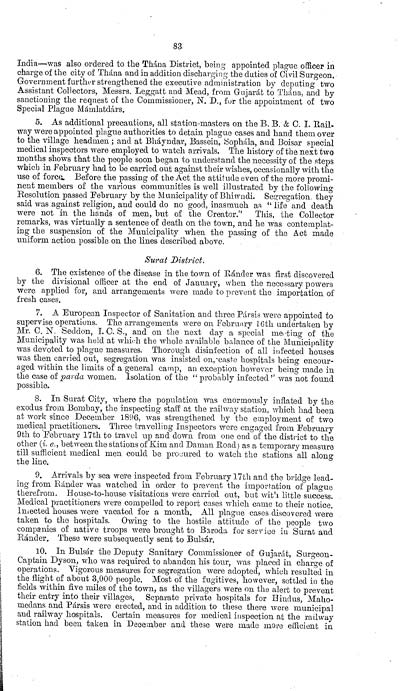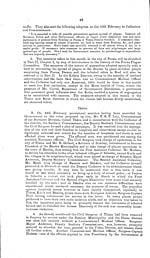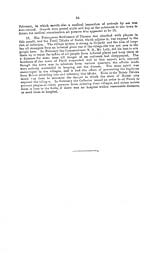Medicine - Disease > Account of plague administration in the Bombay Presidency from September 1896 till May 1897
(95) Page 83
Download files
Individual page:
Thumbnail gallery: Grid view | List view

83
India-was also ordered to the Thna District, being appointed plague officer in charge of the city of Thna and in addition discharging the duties of Civil Surgeon. Government further strengthened the executive administration by deputing two Assistant Collectors, Messrs. Leggatt and Mead, from Gujarat to Thna, and by sanctioning the request of the Commissioner, N. D., fur the appointment of two Special Plague Mmlatdrs.
5. As additional precautions, all station-masters on the B. B. & C. I. Rail-
way were appointed plague authorities to detain plague cases and hand them over to the village headmen; and at Bhyndar, Bassein, Sophla, and Boisar special medical inspectors were employed to watch arrivals. The history of the next two months shows that the people soon began to understand the necessity of the steps which in February had to be carried out against their wishes, occasionally with the use of force. Before the passing of the Act the attitude even of the more prominent members of the various communities is well illustrated by the following Resolution passed February by the Municipality of Bhiwndi. Segregation. they said was against religion, and could do no good, inasmuch as "life and death were not in the hands of men, but of the Creator." This, the Collector remarks, was virtually a sentence of death on the town, and he was contemplating the suspension of the Municipality when the passing of the Act made uniform action possible on the lines described above.
Surat District.
6. The existence of the disease in the town of Rnder was first discovered by the divisional officer at the end of January, when the necessary powers were applied for, and arrangements were made to prevent the importation of fresh cases.
7. A European Inspector of Sanitation and three Prsis were appointed to supervise operations. The arrangements were on February 16th undertaken by Mr. C. N. Seddon, I. C. S., and on the next day a special meeting of the Municipality was held at which the whole available balance of the Municipality was devoted to plague measures. Thorough disinfection of all infected houses was then carried out, segregation was insisted on, caste hospitals being encouraged within the limits of a general camp, an exception however being made in the case of parda women. Isolation of the " probably infected" was not found possible.
8. In Surat City, where the population was enormously inflated by the exodus from Bombay, the inspecting staff at the railway station, which had been at work since December 1896, was strengthened by the employment of two medical practitioners. Three travelling Inspectors were engaged from February 9th to February 17th to travel up and down from one end of the district to the other (i. e., between the stations of Kim and Daman Road) as a temporary measure till sufficient medical men could be procured to watch the stations all along the line.
9. Arrivals by sea were inspected from February 17th and the bridge leading from Rnder was watched in order to prevent the importation of plague therefrom. House-to-house visitations were carried out, but with little success. Medical practitioners were compelled to report cases which came to their notice. Imected houses were vacated for a month. All plague cases discovered were taken to the hospitals. Owing to the hostile attitude of the people two companies of native troops were brought to Baroda for service in Surat and Rnder. These were subsequently sent to Bulsr.
10. In Bulsr the Deputy Sanitary Commissioner of Gujart, Surgeon-Captain Dyson, who was required to abandon his tour, was placed in charge of operations. Vigorous measures for segregation were adopted, which resulted in the flight of about 3,000 people. Most of the fugitives, however, settled in the fields within five miles of the town, as the villagers were on the alert to prevent their entry into their villages. Separate private hospitals for Hindus, Maho-medans and Prsis were erected, and in addition to these there were municipal and railway hospitals. Certain measures for medical inspection at the railway station had been taken in December and these were made more efficient in
India-was also ordered to the Thna District, being appointed plague officer in charge of the city of Thna and in addition discharging the duties of Civil Surgeon. Government further strengthened the executive administration by deputing two Assistant Collectors, Messrs. Leggatt and Mead, from Gujarat to Thna, and by sanctioning the request of the Commissioner, N. D., fur the appointment of two Special Plague Mmlatdrs.
5. As additional precautions, all station-masters on the B. B. & C. I. Rail-
way were appointed plague authorities to detain plague cases and hand them over to the village headmen; and at Bhyndar, Bassein, Sophla, and Boisar special medical inspectors were employed to watch arrivals. The history of the next two months shows that the people soon began to understand the necessity of the steps which in February had to be carried out against their wishes, occasionally with the use of force. Before the passing of the Act the attitude even of the more prominent members of the various communities is well illustrated by the following Resolution passed February by the Municipality of Bhiwndi. Segregation. they said was against religion, and could do no good, inasmuch as "life and death were not in the hands of men, but of the Creator." This, the Collector remarks, was virtually a sentence of death on the town, and he was contemplating the suspension of the Municipality when the passing of the Act made uniform action possible on the lines described above.
Surat District.
6. The existence of the disease in the town of Rnder was first discovered by the divisional officer at the end of January, when the necessary powers were applied for, and arrangements were made to prevent the importation of fresh cases.
7. A European Inspector of Sanitation and three Prsis were appointed to supervise operations. The arrangements were on February 16th undertaken by Mr. C. N. Seddon, I. C. S., and on the next day a special meeting of the Municipality was held at which the whole available balance of the Municipality was devoted to plague measures. Thorough disinfection of all infected houses was then carried out, segregation was insisted on, caste hospitals being encouraged within the limits of a general camp, an exception however being made in the case of parda women. Isolation of the " probably infected" was not found possible.
8. In Surat City, where the population was enormously inflated by the exodus from Bombay, the inspecting staff at the railway station, which had been at work since December 1896, was strengthened by the employment of two medical practitioners. Three travelling Inspectors were engaged from February 9th to February 17th to travel up and down from one end of the district to the other (i. e., between the stations of Kim and Daman Road) as a temporary measure till sufficient medical men could be procured to watch the stations all along the line.
9. Arrivals by sea were inspected from February 17th and the bridge leading from Rnder was watched in order to prevent the importation of plague therefrom. House-to-house visitations were carried out, but with little success. Medical practitioners were compelled to report cases which came to their notice. Imected houses were vacated for a month. All plague cases discovered were taken to the hospitals. Owing to the hostile attitude of the people two companies of native troops were brought to Baroda for service in Surat and Rnder. These were subsequently sent to Bulsr.
10. In Bulsr the Deputy Sanitary Commissioner of Gujart, Surgeon-Captain Dyson, who was required to abandon his tour, was placed in charge of operations. Vigorous measures for segregation were adopted, which resulted in the flight of about 3,000 people. Most of the fugitives, however, settled in the fields within five miles of the town, as the villagers were on the alert to prevent their entry into their villages. Separate private hospitals for Hindus, Maho-medans and Prsis were erected, and in addition to these there were municipal and railway hospitals. Certain measures for medical inspection at the railway station had been taken in December and these were made more efficient in
Set display mode to: Large image | Zoom image | Transcription
Images and transcriptions on this page, including medium image downloads, may be used under the Creative Commons Attribution 4.0 International Licence unless otherwise stated. ![]()
| India Papers > Medicine - Disease > Account of plague administration in the Bombay Presidency from September 1896 till May 1897 > (95) Page 83 |
|---|
| Permanent URL | https://digital.nls.uk/74517200 |
|---|




